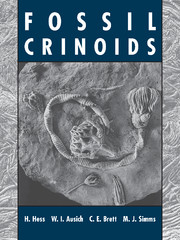Book contents
- Frontmatter
- Contents
- List of Contributors
- Acknowledgements
- Prelude
- Introduction
- GENERAL PART
- ASSEMBLAGES
- 6 Middle Ordovician Trenton Group of New York, USA
- 7 Middle Ordovician of the Lake Simcoe Area of Ontario, Canada
- 8 Upper Ordovician of the Cincinnati, Ohio, Area, USA
- 9 Silurian of Gotland, Sweden
- 10 Middle Silurian Rochester Shale of Western New York, USA, and Southern Ontario, Canada
- 11 Scyphocrinitids from the Silurian–Devonian Boundary of Morocco
- 12 Lower Devonian Manlius/Coeymans Formation of Central New York, USA
- 13 Lower Devonian Hunsrück Slate of Germany
- 14 Middle Devonian Windom Shale of Vincent, New York, USA
- 15 Middle Devonian Arkona Shale of Ontario, Canada, and Silica Shale of Ohio, USA
- 16 Lower Mississippian Hampton Formation at LeGrand, Iowa, USA
- 17 Lower Mississippian Burlington Limestone along the Mississippi River Valley in Iowa, Illinois, and Missouri, USA
- 18 Lower Mississippian Edwardsville Formation at Crawfordsville, Indiana, USA
- 19 Upper Pennsylvanian LaSalle Member, Bond Formation of Central Illinois, USA
- 20 Permian
- 21 Triassic Muschelkalk of Central Europe
- 22 Pentacrinites from the Lower Jurassic of the Dorset Coast of Southern England
- 23 Lower Jurassic Posidonia Shale of Southern Germany
- 24 Middle Jurassic of Southern England
- 25 Middle Jurassic of Northern Switzerland
- 26 Upper Jurassic Solnhofen Plattenkalk of Bavaria, Germany
- 27 Uintacrinus Beds of the Upper Cretaceous Niobrara Formation, Kansas, USA
- 28 Tertiary
- 29 Recent
- Appendix I Geological Time Table with Crinoid Assemblages
- Appendix II Glossary of Rocks
- Bibliography
- General Index
- Taxonomic Index
15 - Middle Devonian Arkona Shale of Ontario, Canada, and Silica Shale of Ohio, USA
Published online by Cambridge University Press: 10 November 2010
- Frontmatter
- Contents
- List of Contributors
- Acknowledgements
- Prelude
- Introduction
- GENERAL PART
- ASSEMBLAGES
- 6 Middle Ordovician Trenton Group of New York, USA
- 7 Middle Ordovician of the Lake Simcoe Area of Ontario, Canada
- 8 Upper Ordovician of the Cincinnati, Ohio, Area, USA
- 9 Silurian of Gotland, Sweden
- 10 Middle Silurian Rochester Shale of Western New York, USA, and Southern Ontario, Canada
- 11 Scyphocrinitids from the Silurian–Devonian Boundary of Morocco
- 12 Lower Devonian Manlius/Coeymans Formation of Central New York, USA
- 13 Lower Devonian Hunsrück Slate of Germany
- 14 Middle Devonian Windom Shale of Vincent, New York, USA
- 15 Middle Devonian Arkona Shale of Ontario, Canada, and Silica Shale of Ohio, USA
- 16 Lower Mississippian Hampton Formation at LeGrand, Iowa, USA
- 17 Lower Mississippian Burlington Limestone along the Mississippi River Valley in Iowa, Illinois, and Missouri, USA
- 18 Lower Mississippian Edwardsville Formation at Crawfordsville, Indiana, USA
- 19 Upper Pennsylvanian LaSalle Member, Bond Formation of Central Illinois, USA
- 20 Permian
- 21 Triassic Muschelkalk of Central Europe
- 22 Pentacrinites from the Lower Jurassic of the Dorset Coast of Southern England
- 23 Lower Jurassic Posidonia Shale of Southern Germany
- 24 Middle Jurassic of Southern England
- 25 Middle Jurassic of Northern Switzerland
- 26 Upper Jurassic Solnhofen Plattenkalk of Bavaria, Germany
- 27 Uintacrinus Beds of the Upper Cretaceous Niobrara Formation, Kansas, USA
- 28 Tertiary
- 29 Recent
- Appendix I Geological Time Table with Crinoid Assemblages
- Appendix II Glossary of Rocks
- Bibliography
- General Index
- Taxonomic Index
Summary
The two related fossil assemblages discussed in this chapter occur in possibly age-equivalent Middle Devonian mudstones in southern Ontario and Ohio (Fig. 137). The Arkona Shale is exposed along the banks of the Ausable River and in its tributary streams in the vicinity of Arkona, Lambton County, Ontario, Canada. The Silica Shale is exposed in the quarries of the Medusa Cement Company and the New Genstar Cement Company, both north and south of Centennial Road in the town of Silica, Lucas County, Ohio. These mudstones are considered to be in the lower part of the Hamilton or Traverse Group and are of Early Givetian age, approximately 385 million years before present.
LIMESTONE LENSES WITH BRYOZOANS, BRACHIOPODS, TRILOBITES AND COMPLETE CRINOIDS
The thin skeletal limestone lenses within the Arkona and Silica Shales carry a moderately diverse fauna of bryozoans, brachiopods, gastropods, bivalves and trilobites, as well as crinoids and blastoids. Approximately 40–50 species can be found with considerable effort. The Silica fossils are described in a richly illustrated volume compiled by Kesling and Chilman (1975). Among the most common fossils are the stick-like bryozoans, Sulcoretepora, as well as Fenestella. Brachiopods include abundant, small, concavo-convex chonetids and Mucrospirifer. The trilobite Phacops is also commonly associated and has been found in clumps of articulated individuals in the Silica Shale of Ohio; it has become the landmark of these strata and is a highly valued collector's item. The surrounding mudstones are quite sparsely fossiliferous, but do occasionally contain isolated specimens of chonetids, Mucrospirifer and other brachiopods. Scattered, pyritized specimens of small bivalves (nuculids), goniatites and bactritids also occur.
- Type
- Chapter
- Information
- Fossil Crinoids , pp. 129 - 134Publisher: Cambridge University PressPrint publication year: 1999
- 1
- Cited by



